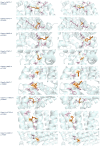Clinical and genetic analysis of children with glucose transporter type 1 deficiency syndrome
- PMID: 39092009
- PMCID: PMC11289861
- DOI: 10.3892/mi.2024.181
Clinical and genetic analysis of children with glucose transporter type 1 deficiency syndrome
Abstract
Glucose transporter type 1 deficiency syndrome (GLUT1-DS) is a rare metabolic encephalopathy with a wide variety of clinical phenotypes. In the present study, 15 patients diagnosed with GLUT1-DS were selected, all of whom had obvious clinical manifestations and complete genetic testing. Their clinical data and genetic reports were collated. All patients were provided with a ketogenic diet (KD) and an improvement in their symptoms was observed during a follow-up period of up to 1 year. The results revealed that the 15 cases had clinical symptoms, such as convulsions or dyskinesia. Although none had a cerebrospinal fluid/glucose ratio <0.4, the genetic report revealed that all had the solute carrier family 2 member 1 gene variant, and their clinical symptoms basically improved following the use of the KD. GLUT1-DS is a genetic metabolic disease that causes a series of neurological symptoms due to glucose metabolism disorders in the brain. Low glucose levels in cerebrospinal fluid and genetic testing are key diagnostic criteria, and the KD is a highly effective treatment option. By summarizing and analyzing patients with GLUT1-DS, summarizing clinical characteristics and expanding their gene profile, the findings of the present study may be of clinical significance for the early recognition and diagnosis of the disease, so as to conduct early treatment and shorten the duration of brain energy deficiency. This is of utmost importance for improving the prognosis and quality of life of affected children.
Keywords: children; epilepsy; glucose transporter type 1 deficiency syndrome; ketogenic diet; solute carrier family 2 member 1.
Copyright: © 2024 Qian et al.
Conflict of interest statement
The authors declare that they have no competing interests.
Figures


Similar articles
-
[Clinical characteristics and ketogenic diet therapy of glucose transporter type 1 deficiency syndrome in children: a multicenter clinical study].Zhonghua Er Ke Za Zhi. 2020 Nov 2;58(11):881-886. doi: 10.3760/cma.j.cn112140-20200822-00819. Zhonghua Er Ke Za Zhi. 2020. PMID: 33120458 Chinese.
-
Occurrence of GLUT1 deficiency syndrome in patients treated with ketogenic diet.Epilepsy Behav. 2014 Mar;32:76-8. doi: 10.1016/j.yebeh.2014.01.003. Epub 2014 Feb 6. Epilepsy Behav. 2014. PMID: 24508593
-
Clinical and Genetic Characteristics of Chinese Children With GLUT1 Deficiency Syndrome: Case Report and Literature Review.Front Genet. 2021 Nov 22;12:734481. doi: 10.3389/fgene.2021.734481. eCollection 2021. Front Genet. 2021. PMID: 34880899 Free PMC article.
-
The expanding phenotype of GLUT1-deficiency syndrome.Brain Dev. 2009 Aug;31(7):545-52. doi: 10.1016/j.braindev.2009.02.008. Epub 2009 Mar 21. Brain Dev. 2009. PMID: 19304421 Review.
-
Phenotypic spectrum of glucose transporter type 1 deficiency syndrome (Glut1 DS).Curr Neurol Neurosci Rep. 2013 Apr;13(4):342. doi: 10.1007/s11910-013-0342-7. Curr Neurol Neurosci Rep. 2013. PMID: 23443458 Review.
Cited by
-
Role of the renin-angiotensin pathway in epilepsy: a strategy for its management by drug repurposing.Mol Biol Rep. 2025 Jul 10;52(1):695. doi: 10.1007/s11033-025-10776-w. Mol Biol Rep. 2025. PMID: 40637915 Review.
References
-
- Soto-Insuga V, López RG, Losada-Del Pozo R, Rodrigo-Moreno M, Cayuelas EM, Giráldez BG, Díaz-Gómez E, Sánchez-Martín G, García LO, Serratosa JM. Glut1 deficiency is a rare but treatable cause of childhood absence epilepsy with atypical features. Epilepsy Res. 2019;154:39–41. doi: 10.1016/j.eplepsyres.2019.04.003. Grupo Español de Genética de las Epilepsias de la Infancia (GEGEI) - DOI - PubMed
LinkOut - more resources
Full Text Sources
Miscellaneous
